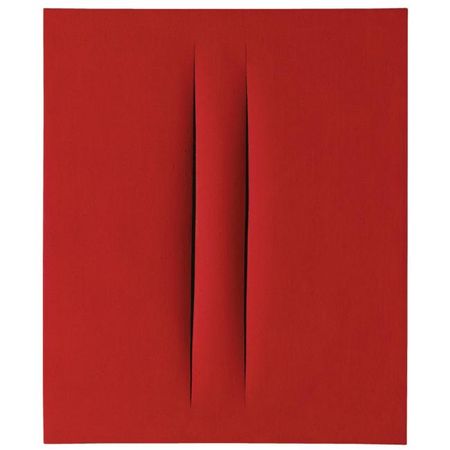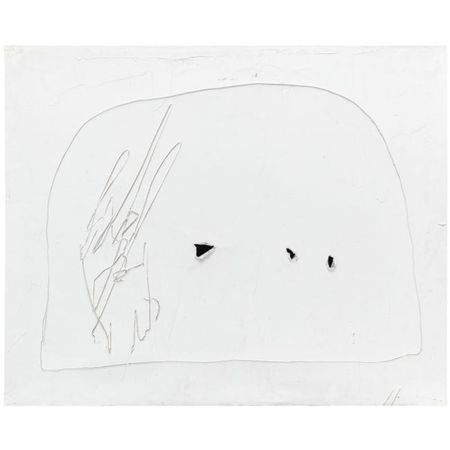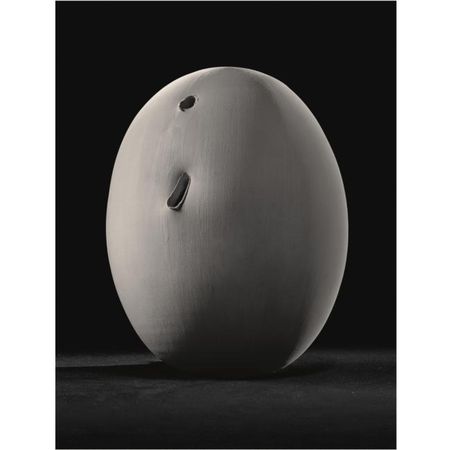Three Lucio Fontana's "Concetto spaziale" @ Sotheby's
Lucio Fontana (1899 - 1968), Concetto spaziale, Attese. photo courtesy Sotheby's
waterpaint on canvas. signed, titled and inscribed Duecento, trecento, quattrocento - mille on the reverse. 55 by 46.5cm. Executed in 1966. Est. 300,000—400,000 GBP - Sold 457,250 GBP
PROVENANCE: Anna Daelli, Milan
Private Collection, Milan
Sale: Sotheby's, London, Post-War and Contemporary Art, 20 May 1987, Lot 370
Gallery Art Point, Tokyo
Private Collection, Tokyo
Acquired from the above by the present owner
EXHIBITED: Tokyo, Tama Art University Museum, Lucio Fontana. Spatial Conception, 1990, p. 58, no. 54, illustrated in colour
LITERATURE AND REFERENCES: Enrico Crispolti, Lucio Fontana Catalogue Raisonné, Brussels 1974, vol. II, pp. 184-185, no. 66 T 82, illustrated
Enrico Crispolti, Lucio Fontana Catalogo Generale, Milan 1986, vol. II, p. 645, no. 66 T 82, illustrated
Enrico Crispolti, Lucio Fontana Catalogo Ragionato, Milan 2006, vol. II, p. 840, no. 66 T 82, illustrated
NOTE: Produced in 1966, the year in which Fontana was awarded the International Grand Prize for Painting at the XXXIII Venice Biennale, Concetto Spaziale, Attese epitomizes the artist's groundbreaking explorations in Spatialism. This red variation on Fontana's signature Concetto Spaziale fuses together sensual intimations and the artist's research in conceptually translating infinity of space into the canvas. Exquisitely executed, the two lyrical slashes simultaneously evince spontaneity and control. The rich, saturated layer of red waterpaint allows the weave of the canvas to show through, insistently drawing attention to the materiality of the artwork. With a sculptor's sensibility, Fontana discarded conventional reverence for the canvas, and instead treated it as an artistic object in its own right. As an image of spatial reality, Fontana emphasises the canvas's presence with bold, invasive gesture. Fontana, cutting directly into the canvas, creates a beautiful contrast to the delicacy of the waterpaint.
In Concetto Spaziale, Attese Fontana performed surgery on the very concept of painting, committing sacrilege on Clement Greenberg's high altar of Modernism, the flat picture plane. As Fontana declared in his last recorded interview: "I make a hole in a canvas in order to leave behind the old pictorial formulae, the painting and the traditional view of art and I escape, symbolically, but also materially, from the prison of the flat surface" (conversation with Tommaso Trini, July 19, 1968, in Exhibition Catalogue, Amsterdam, Stedelijk Museum; London, Whitechapel Art Gallery, Lucio Fontana, 1988, p. 34). This inquiry into the grey area between painting and sculpture takes a particularly alluring form in the brilliant red of the present Concetto Spaziale, Attese.
In the present work, our eye and our mind are forced by the visual pureness of the cuts opened on a red, fiery background, to meditate upon what lies beyond and behind the canvas surface.
Lucio Fontana (1899 - 1968), Concetto spaziale. photo courtesy Sotheby's
oil on canvas. signed. 80 by 100cm. 80 by 100cm. Est. 350,000—450,000 GBP - Sold 385,250 GBP
PROVENANCE: Galerie Schmela, Düsseldorf
Galerie Gunar, Düsseldorf
Sale: Finarte, Milan, 16 October 1986, Lot 187
Acquired directly from the above by the present owner
EXHIBITED: Milan, Galleria Civica d'Arte Moderna; Rome, Palazzo delle Esposizioni, Mostra della Critica Italiana 1961, 1961-1962, p. 40, no. 44, illustrated
Wuppertal, Kunst-und Museumverein, Hommage à Fontana, 1969, no. 25
LITERATURE AND REFERENCES: Enrico Crispolti, Lucio Fontana Catalogue Raisonné, Brussels 1974, vol. II, p. 112, no. 61 O 65, illustrated
Enrico Crispolti, Lucio Fontana Catalogo Generale, Milan 1986, vol. I, p. 376, no. 61 O 65, illustrated
Enrico Crispolti, Lucio Fontana Catalogo Ragionato, Milan 2006, vol. II, p. 564, n. 61 O 65, illustrated
NOTE: Exhibiting rich painterly virtuosity, Concetto Spaziale delivers a sublime effect of material density, a lyrically asymmetrical composition, and a certain aesthetic pureness that is archetypal of Lucio Fontana's celebrated Olii. Executed in 1961 simultaneously with the Venezia cycle, the present work witnesses the fruitful union of the artist's spatial experiments from the 1950s with his recent ventures in oil paint, whose thicker and heavier form had re-awakened the sculptor in Fontana. In contrast with the Baroque aesthetics of the Venezie, Concetto Spaziale masterfully condenses the pureness of Fontana's gesture with his painterly ability.
The dense surface has been built up with layer upon layer of thick paint, creating a heavy, textured skin onto which Fontana has incised a matrix of fluid sweeping gestures and pierced a sequence of holes. These energised painterly and sculptural marks seem to orbit within a semicircular line which stages the rhythm of the composition and seems to anticipate Fontana's Teatrini series (1964-66). The present work also further consolidates Fontana's ongoing series of Buchi, which are here used in conjunction with and also as a counterfoil to the fluid and dynamic painterly surface. Now able to convey space and movement across the entire picture plane through the thick surface as well as gesture, these delicate holes break through the canvas with a real sense of power and depth, becoming themselves rapid streaks of energy that seem to originate from the inner core of the composition.
In Fontana's oeuvre the space enters the painting as a tangible reality and an aesthetic gesture. First in the Buchi series (1949), in which the canvas is punctured; then in the Pietre series (1952), in which fragments of Murano glass pebbles are added to the canvas; finally in the Tagli series (1958), in which the canvas is slashed. All these different approaches extend the traditional boundaries of painting, by offering lyrical solutions to the desire to penetrate beyond the confines of the surface. The Olii series condenses both the conceptual and material advancements of Fontana's experimental precedent using the highest artistic medium.
Reaching his artistic maturity in the aftermath of World War II, a time of radical social, political and technological change, the artist was profoundly impressed by the restless achievements of science, and in particular by space exploration. Just as the Futurists at the beginning of the century had tried to capture the essence of modern life, Fontana aspired to find a poetic articulation and an aesthetic metaphor for the conquest of space. Fontana investigated new solutions of rendering this sense of 'spatial dynamism', inspired in his pictorial and sculptural innovations by the legacy of Futurism and Baroque, which the artist formalized in his treatise Manifesto Bianco (1946). Concetto Spaziale was painted at the same time as Yuri Gagarin's momentous first manned flight into space and beautifully conveys the artist's fascination with the mysteries of space and matter. This meant for him 'materializing' the space, making visible the invisible, making palpable the impalpable. As he explained "A butterfly in space excites my imagination: having freed myself from rhetoric, I lose myself in time and begin my holes." (the artist cited in: Leonardo Sinisgalli, Pittori che scrivono. Antologia di scritti e disegni, Milan 1954, p. 115).
Concetto Spaziale perfectly represents Fontana's groundbreaking achievement in Spatialism. With its rich surface texture and irregular patterns and apertures Concetto Spaziale mediates between painting and sculpture communicating a great sense of movement and dynamism. The raised rims around the holes indicate how Fontana incised their shape while the paint was still drying. The choice of an absolute white colour translates Fontana's research of dematerialization of the pictorial surface towards pure spatiality in a sort of purification path.
The viewer's eye and mind are forced to meditate upon what lies beyond the canvas surface. The delicate white colour finally appears as a pure cosmos incised by a trascendent vital and phenomenological energy. The result is a surface of sublime rarefied beauty, where there are no boundaries for the artist's expressive freedom.
Lucio Fontana (1899 - 1968), Concetto spaziale. photo courtesy Sotheby's
painted terracotta. signed. 33 by 24 by 24cm. Executed in 1960-1965, this work is registered in the Fondazione Lucio Fontana, Milan under number 1367/19. Est. 45,000—55,000 GBP - Lot sold 145,250 GBP
PROVENANCE: Sale: Finarte, Milan, 17 May 1980, Lot 29
Acquired directly from the above by the present owner
EXHIBITED: Turin, Museo Internazionale delle Arti Applicate Oggi, Astronave Torino, 2007-2008, n.p., tab. X, illustrated
Sotheby"s. 20th Century Italian Art . 16 Oct 09. London www.sothebys.com

/https%3A%2F%2Fprofilepics.canalblog.com%2Fprofilepics%2F1%2F0%2F100183.jpg)





/http%3A%2F%2Fstorage.canalblog.com%2F74%2F31%2F119589%2F66173465_p.jpg)
/http%3A%2F%2Fstorage.canalblog.com%2F34%2F37%2F119589%2F66154920_p.jpg)
/http%3A%2F%2Fstorage.canalblog.com%2F35%2F87%2F119589%2F66137125_p.jpg)
/http%3A%2F%2Fstorage.canalblog.com%2F82%2F19%2F119589%2F65179163_p.jpg)